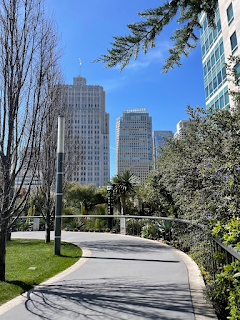Pop of colour in an urban jungle: Last day of winter at the #Salesforce Park
I had an exam in the City in mid-March and brought my meal-prepped lunch. So I hopped into a lift that brought me to Salesforce Park (for the first time). It is a garden 70 feet above ground, suspended over three or four city blocks in the East Cut neighbourhood. It is a sight for sore eyes after being on the BART and walking on San Francisco's concrete trails under the shadow of the tall buildings of the Financial District.
Salesforce Park reopened in July 2019, a few months after I finished studying in the City. In fact, the construction site for the Transbay Transit Centre (on which the park is found) was under construction while I was a student at UC Berkeley's SF campus. And that is why I didn't get a chance to see it earlier.
The park is divided into different zones based on how the plants are grouped. The areas basking in sunlight during my visit included the desert garden, the California garden, the fog garden, and the Chilean garden. The rest of the park was in shadow. Nevertheless, walking the loop was relaxing because there were so many plants! The bamboo grove was one of the best features because it was cool, shaded, and less crowded.
After lunch, I couldn't stay longer for the fast-paced walk around the loop. I would have loved to walk there more leisurely, but I had to go further into the Financial District to get to my exam venue.








Comments
Post a Comment
Thank you for dropping by!
Before moving on, please share your thoughts or comments about the post. :)
Thanks again!